OP-ED
One of the biggest drivers of rhino extinction is social inequality
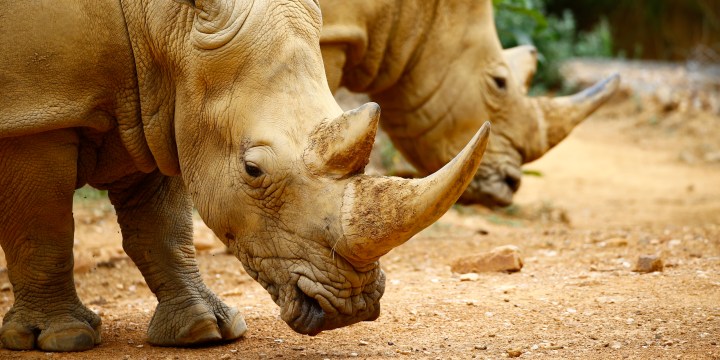
A recent insightful South African report on the rhino crisis advocates that it is finally time to put theory into practice. Unless local communities on park borders are empowered, the fate of the rhino is bleak.
According to the WWF’s significant “Living Planet” report released at the end of October 2018, humanity’s impact on planetary ecosystems has led to the extinction of 60% of animal species. In South Africa — and indeed globally — saving the rhino has become a symbolic quest for us as a species. The rhino is a majestic, ancient-looking beast of beauty, one of the last of the legendary megafauna to walk this Earth, and there’s a sense that if humanity can rescue the rhino from extinction, perhaps we can save other species — and ultimately ourselves. For, if we’re honest, even the dim spectre of our own extinction hovers on the dark fringes of our vision.
A crucial issue that the rhino crisis raises is how our cultural beliefs trump our empathy. While many in China and Vietnam may fantasise about the power of the rhino horn, for plenty of Global North trophy-hunters, killing a rhino would top their bucket list.
In those scenarios, empathy for the rhino is low and motivations of self-medication and self-aggrandisement are high. Yet, a provocative recent report from UCT’s Global Risk Governance Programme lead-authored by senior researcher Dr Annette Hübschle and co-authored by Dr Clifford Shearing, argues that saving the rhino can more effectively be achieved by extending our societal empathy not only to the rhino, but importantly also to local poverty-stricken communities living on the edges of national parks. Rather than investing in divisive, violent paramilitary operations, the report is a clarion call for investing in community-wildlife integration projects.

Hübschle was honoured internationally as Sociologist of the Month by Current Sociology in September 2018, and her co-authored comprehensive report, Ending Wildlife Trafficking: Local communities as change agents was supported by UCT and the Global Initiative Against Transnational and Organised Crime. It locates the rhino poaching crisis within the historical realities of colonial dispossession: When the Kruger National Park was formed as a much-needed sanctuary for wild animals (after their numbers had been decimated by the colonial overlord big-game hunters), the wildlife was forced off land earmarked for farming, and into South Africa’s reserves. Meanwhile, communities who lived in the park areas — and had lived off the land for centuries — were forced out of the park boundaries and excluded from park benefits.
While this was very much a colonial apartheid form of governance, the post-apartheid era — plagued with corruption and State Capture — has seen virtually no dismantling of the crippling nationwide structural inequalities created under apartheid. In short, there’s been minimal integration of local communities into the economic benefits offered by the national park. As Hübschle asserts, the 1% Kruger National Park tourism levy “and other initiatives, such as the South African National Parks corporate social investment programme, have limited impact, as the funds have to be spread very thinly or do not reach those most in need”.
More than half of South Africans live in poverty, and in a society struggling under the weight of such imbalances, it’s unsurprising that “desperate times call for desperate measures”. Social and economic inequality and the continued exclusion from benefit schemes are the real culprits driving poachers to risk their lives for cash:
“Often the only pathway out of poverty available to people in rural areas is through participation in illegal wildlife economies.”
In a focus group with people in the greater Kruger National Park in December 2017, Hübschle heard:
“The rhino has its own doctor, its own policeman, its own helicopter, its own land and there are rangers that protect it. We don’t have these things. If the rhino goes extinct tomorrow, maybe we can finally get these things.”
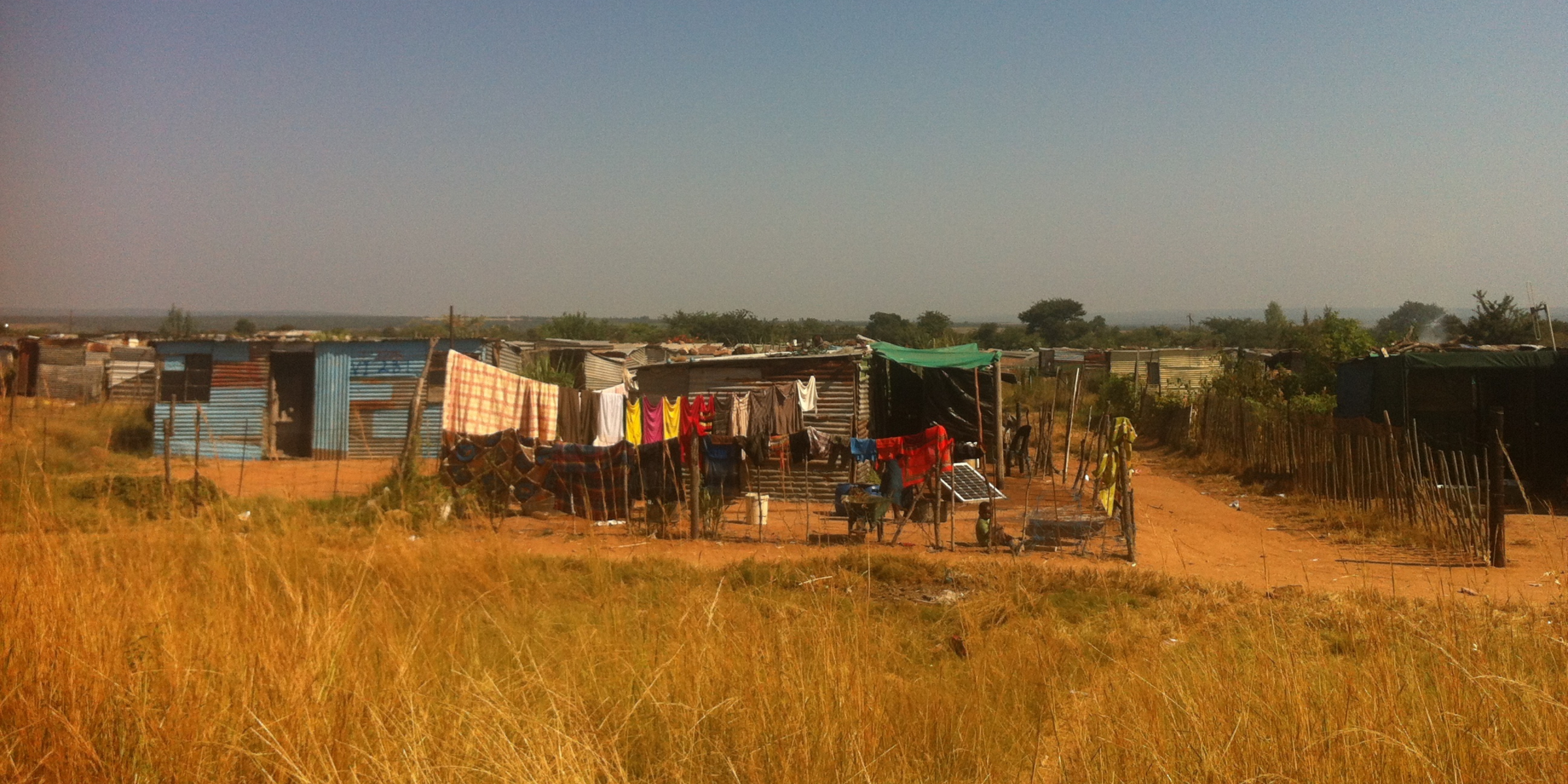
Living on the edge: Rural settlement, Limpopo province, South Africa (Photo: Annette Hübschle)
The idea that those with financial power care more about wild animals — in this case rhinos — than rural people living in poverty is divisive, and leads many park border communities to directly or indirectly support poaching efforts. The report points out that poachers are seen as the Robin Hoods by local communities:
“Some locals provide support services to poachers, such as accommodation, food and drink, intelligence, traditional medicine, and tracking and transport. In return, rhino poachers and traffickers provide the communities with material assistance and money where the state and conservation authorities have failed to assist.”
This isn’t always the case though, as Hübschle observes:
“One poacher in his mid-20s argued that, because he bore the risk alone during his poaching sorties in the KNP, he was not prepared to share his profits with the community. ‘It benefits me, I don’t give to the community,’ he said.”
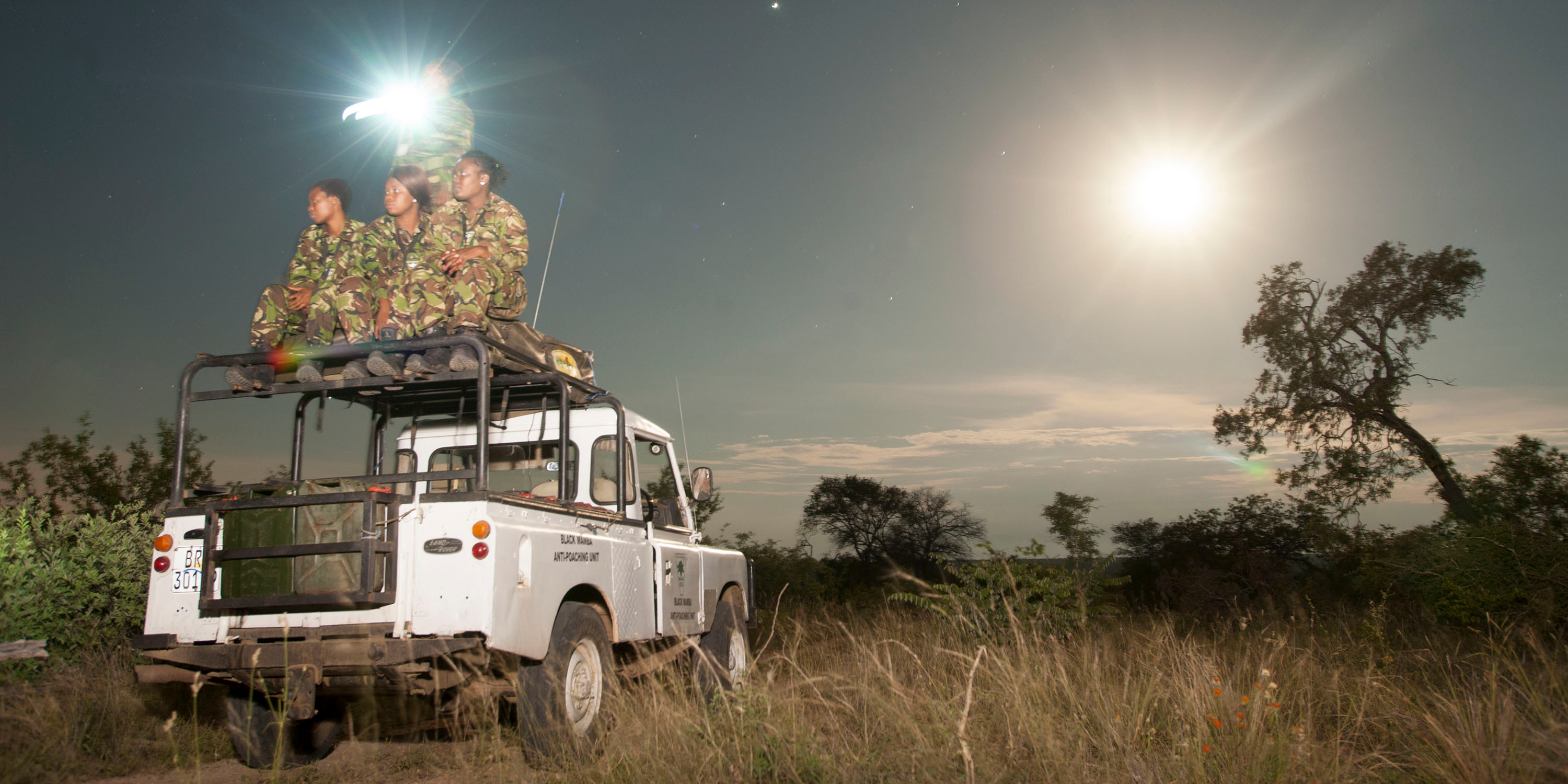
Members of the female Black Mamba anti-poaching unit, Balule, South Africa (Photo: Jeffrey Barbee)
Integral to the report are the ground-breaking interviews with local communities and poachers, and the access Hübschle gained to these key players is impressive. Hübschle is committed to addressing the rhino crisis.
“I grew up in Namibia in the 1980s and 1990s where SADF (South African Defence Force) soldiers and their Unita (The National Union for the Total Independence of Angola) associates decimated local elephant and rhino populations, swapping tusks and horns for arms and ammunition. So the rhino’s precarious existence has been on my mind for more than 30 years.
“In my professional life as a criminologist and sociologist, I have been researching organised crime and African security issues for two decades,” she says.
Hübschle’s doctorate was undertaken at the Max Planck Institute for the Study of Societies in Cologne, Germany:
“I chose to research the market in rhino horn. I followed rhino horn from the source to the market with the objective of trying to understand why the supply chain is so resilient despite the myriad measures implemented to disrupt it.
“While much of the international focus is on demand reduction strategies in wildlife markets, attempts to disrupt horn supplies are relegated to tactical anti-poaching measures, including the securitisation and militarisation of conservation in the so-called ‘war on poaching’ and criminal justice responses. Communities living near protected areas are often framed as ‘criminalised communities’, ‘poaching villages’ or ‘false economies’.”
It is these perceived “criminalised communities” that interested Hübschle, and her report indicates a tangible engagement with the issues faced by the rural poor living on the margins of society — including poachers. How did she gain the trust of the communities and poachers she interviewed?
“At the time of my initial interviews, many of the active poachers and kingpins thought that poaching constituted a legitimate livelihood. In fact, they called themselves ‘professional hunters’, ‘hunters’, ‘business entrepreneurs’ or ‘development workers’. I had to follow usual research protocols of seeking permission from traditional leaders and elders to speak to community members.
“Some poachers and kingpins took their own security precautions to ensure that I was not a park, police or intelligence officer. I also applied for a research permission to the Department of Correctional Services. The research permit provided access to convicted poachers and traffickers in South African correctional centres.
“There is very little incentive for prisoners to speak to a researcher. Many were strewn in far-flung prisons in rural areas where they were not receiving visitors, so talking to me provided a welcome distraction from prison life. I held honest conversations with prisoners, not prying for information on their modus operandi, but exploring their social worlds and reasons for offending.”

Weighing rhino horn (Photo: Annette Hübschle)
With these insights, Hübschle argues in her report that communities are “the missing link” and “should be considered fulcrum institutions when it comes to the prevention of wildlife crime and disruption of trafficking networks. The supply chain and trafficking networks are rendered useless when communities pull out and no longer support illegal wildlife economies.”
It’s the age-old human-wildlife conflict, a conflict which has brought our species to a brink, and instead of seeing the solution in “a militarised response — more boots on the ground, helicopter gunships and new technologies”, Hübschle challenges that we need to attempt to forge a solution that complements the needs of humans and wildlife.
In short, rather than our current strategy of enacting a conservation apartheid on those outside the borders of national parks, transformation is needed in South African conservation:
“Wildlife conservation has always benefited economic and political elites while local and indigenous communities have remained mostly excluded from the benefits. At the heart of the rhino poaching crisis and the illicit trade, therefore, is a conflict over access to resources, benefits and land.”
Conservation transformation — moving beyond extending the fruits of conservation to poor communities, but actually allowing the communities to become viable partners in conservation efforts, is not a new idea — but it is a concept that causes much polarisation in conservation circles. Hübschle’s report outlines how most of the pressing extinction issues affect the Global South, and yet policy is decided from the Global North, enacting a new form of colonialism: A colonialism of remote-control.
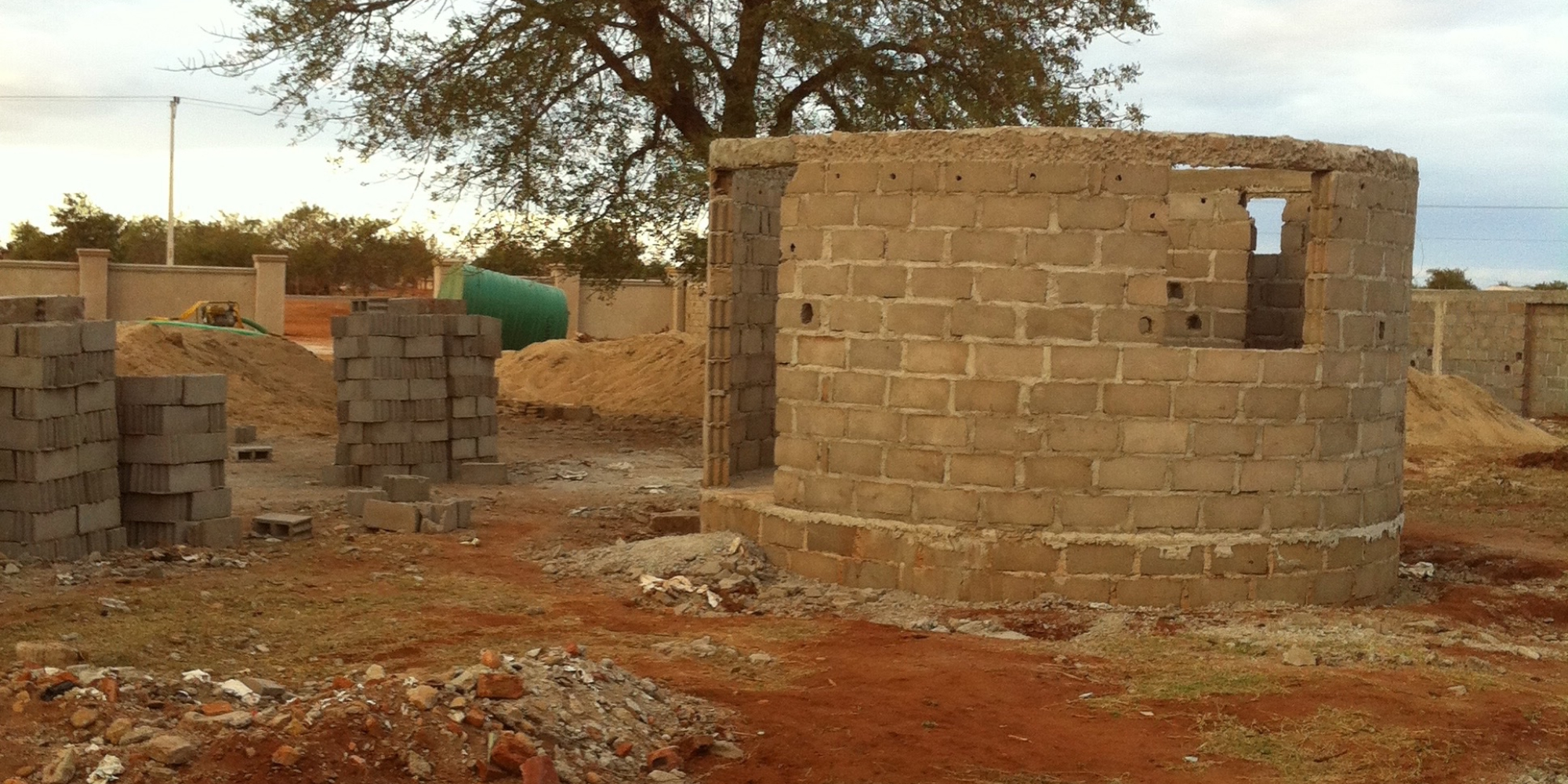
Buildings in Massingir, Mozambique, built from rhino horn profits (Photo: Annette Hübschle)
Wading into the controversial waters of the CITES North-South debate, Hübschle’s report notes that SADC representatives are dissatisfied about how their needs have been addressed by CITES:
“The question arose as to why Africans should preserve Western-style safari parks filled with wild animals for the enjoyment of affluent tourists while their own families were struggling to make ends meet. Moreover, it was noted that European countries had failed dismally in conserving their own ‘wilderness’ areas and endangered species.
“The northern lobby is seen as able to influence CITES listing decisions that are detrimental to African rural communities. Compensation is seldom paid for listings that affect rural livelihoods.”
While CITES is trying to do its best for animals under threat, it’s clear that a more integrated approach needs to be taken. If communities are relegated to the margins in key CITES debates, the outlook for the rhino and other endangered species is bleak. Hübschle observes:
“There is a significant lobby within the environmental movement (predominantly from the Global North) that is vehemently opposed to any form of trade in animal species, particularly when it is premised on the killing of these animals. This lobby holds considerable sway at CITES, directly and indirectly informing decisions that lead to restrictions on trade in wildlife.”
It is understandable that animal rights players from the Global North don’t want any threatened animals to be killed However, seen from the reality of those living in poverty on the edges of the park, this logic is culturally loaded. It’s very much like an ethical vegetarian standing at a braai being interrogated about why they care about the dead animals everyone else is relishing eating.
While arguments could ensue that a rhino is threatened and cattle or sheep are not, seen from the perspective of someone living in poverty who is not culturally acclimatised to the rhino issues, the rhino is just another animal — and a valuable resource at that. As Hübschle points out:
“A different way of addressing the problem is needed if we are to make a live rhino more valuable to rural communities than a dead one.”
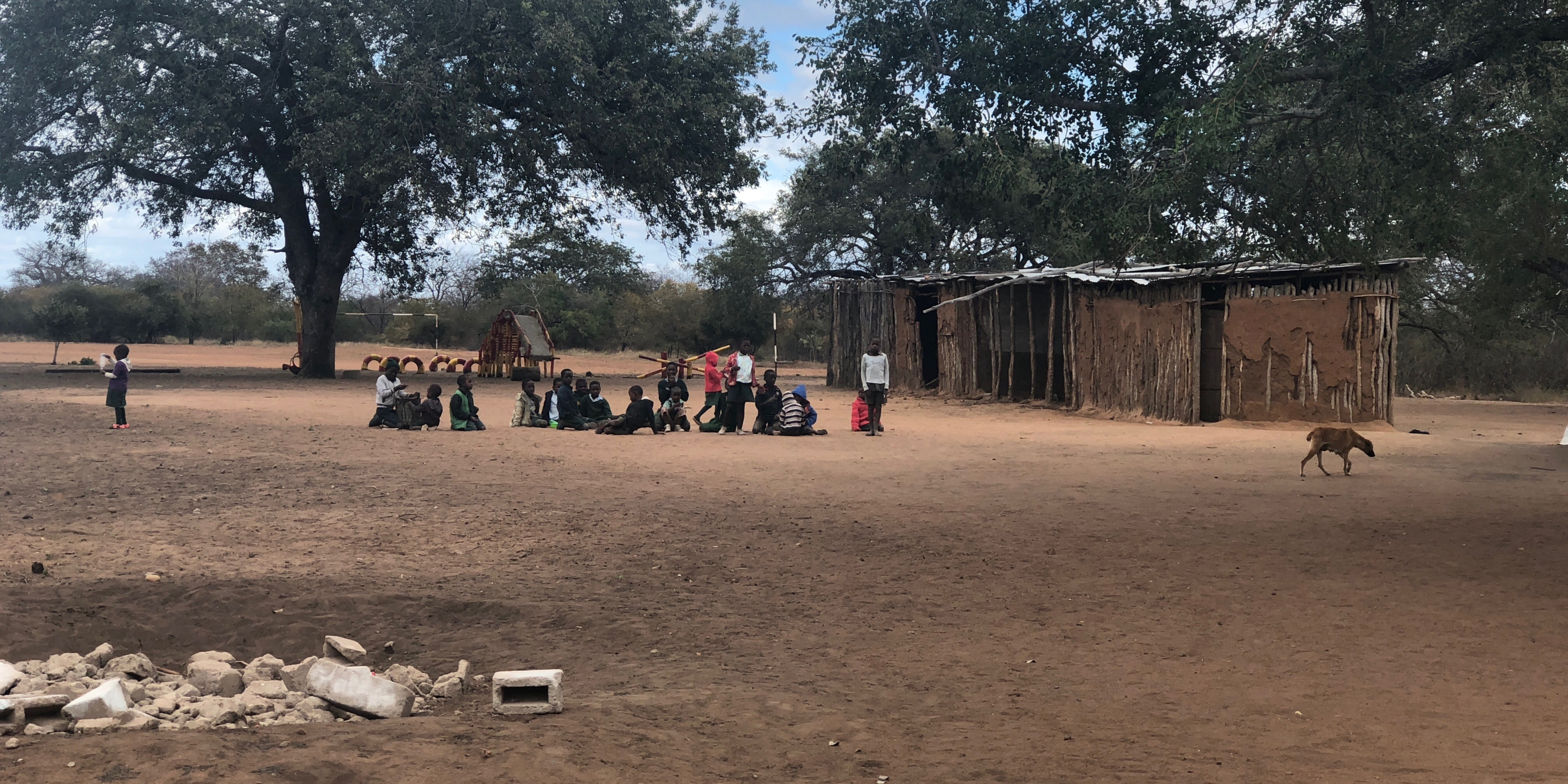
Primary school in Chilotlela, Zimbabwe (Photo: Annette Hübschle)
Hübschle noted in her in her interview that CITES should “make sure that a Committee for Rural Communities is established as a matter of urgency (detailed in the report). The Global North is over-represented in decision-making positions. The keepers of most of the remaining wildlife should have fair representation and this includes local communities who have to shoulder the costs of living with or near wild animals.”
No conservation strategy will ever be successful without admitting that it is located within a human environment, and empathetically considering the humans in that environment is crucial to pushing back the extinction of many species.
Those trapped in poverty (it’s not called the poverty trap for nothing — lifting oneself out of poverty is extremely tough, and like all other success relies on a blend of wilful perseverance and sheer luck) need to be included as what Hübschle calls “change agents” in turning back species extinction. If we want to save the rhino, we need to consider those who have the power to do so. In this case, those who have the power are ironically society’s most marginalised people. As Hübschle articulates:
“The map of power does not lie behind the barrel of a gun, but in the goodwill of local people living with and near wildlife. One of the key research findings of my ongoing research is the significant role of women in mediating positive conservation outcomes. Women command considerable power and influence in the communities in question. In light of the patriarchal structure of many rural African communities, this suggestion may appear counter-intuitive. However, there are countless examples that demonstrate that women can exert a strong influence on conservation outcomes.”
In searching for solutions to the crisis, Hübschle’s report analyses several case studies from Africa to Nepal, where communities (even some who were virtually at “war” with park authorities) have been integrated into rhino conservation efforts. She assesses how different countries have attempted to integrate communities into the parks: Zimbabwe’s CAMPFIRE project has struggled under the weight of elitism and mismanagement — and the benefits to the communities are minimal.
The complexities of the issues are never glossed over, and each model has had its own challenges, successes and critics. Some of the case studies have been more successful than others. Rhino ranching — where the horn is harvested without the rhino being killed, and can grow back — is proposed by the Balepye and Selwane Community Rhino Conservation and Sustainable Game Ranching Project in Limpopo in South Africa, and may offer some real hope for local communities.
Not only would it provide much-needed income, but it would also mean that communities would be determined to safeguard their income. One rhino horn trafficker admitted:
“As a person who used to do [poaching], I will love to be part of solution to this problem. I am one of those who wish to farm my own rhinos. If you want to stop this, speak to me.”
The answers don’t only lie with including communities in conservation efforts, and Hübschle admitted in her interview that, “there are limits to what conservation authorities can do to uplift communities that live near national parks”.
“But it is important to explore other forms of rural employment, resource sharing and income generation beyond hunting, anti-poaching and tourism. Local needs and services should be provided through community empowerment projects. Instead of bringing in experts to deliver services, teachers and trainers should be hired to teach community members the skills needed to build, develop and maintain their own projects, including infrastructure development. Indigenous knowledge systems and values should be harnessed for such community projects.”
While the report acknowledges that there are many complex moving parts to the illicit trade in rhino horn, Hübschle contends:
“Donor funding that is ring-fenced for law enforcement should be used to ‘follow the money’ and dismantle trafficking networks.” Her solution-oriented report also suggests money currently being spent on “anti-poaching to interventions” should be channelled to “interventions that support communities”. As she noted in her interview:
“Criminal actors have seized an opportunity, which could be undone by engaging with those communities affected by economic and physical displacement, loss of agency and systematic alienation. There is a need to listen to the grievances, hopes and wishes of communities.”
An important part of Hübschle’s research is to engage with government:
“I have presented the findings of my research to southern African policy-makers, including our late Minister of Environmental Affairs, Edna Molewa, and the Parliamentary Portfolio Committee on Environmental Affairs. My critique of the ‘war on poaching’ framing and the proposal to centre local communities as fulcrum institutions have been well received and supported.
“Conservation actors, policymakers, donors and communities should move beyond the premise of the fortress conservation paradigm, which assumes conflictual relationships between rural communities and wildlife.”
It’s an important call to action, and one that urgently needs to heard, acknowledged and implemented if the rhino is to be part of humanity’s future.
As a country, South Africa needs to seriously acknowledge that the structural inequalities need to be addressed as a matter of urgency if we want not only to save the rhino, but also move forward as more harmonious and prosperous nation. DM
Read and download Dr Annette Hübschle and Dr Clifford Shearing’s full report here.

















 Become an Insider
Become an Insider